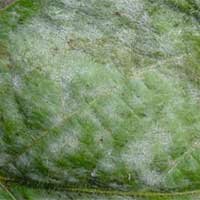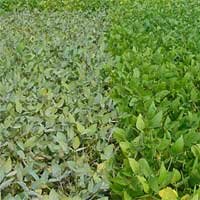
-
Soybean Diseases
- Asian Rust
- Anthracnose
- Bacterial Blight
- Bacterial Pustule
- Bean Pod Mottle Virus
- Brown Stem Rot
- Cercospora Leaf Blight
- Charcoal Rot
- Downy Mildew
- Frogeye Leaf Spot
- Green Stem Syndrome
- Iron Deficiency Chlorosis
- Phytophthora Root & Stem Rot
- Powdery Mildew
- Rhizoctonia
- Seedling Diseases
- Septoria (Brown Spot)
- SCN (Soybean Cyst Nematode)
- Soybean Mosaic Virus
- Stem Canker
- Sudden Death Syndrome
- Viruses
- White Mold
- Soybean Pests
- Diagnostic Help
- Field Trials
- Soybean Library
Your Soybean Checkoff.
Delivering Results.
Illinois
Indiana
Iowa
Kansas
Michigan
Minnesota
Missouri
Nebraska
North Dakota
Ohio
South Dakota
Wisconsin
Powdery Mildew
Powdery mildew is a common leaf disease of many crop and ornamental plants, including soybean. Soybean powdery mildew is caused by the fungus Microsphaera diffusa.
Powdery mildew on soybean requires cool air temperatures and low relative humidity. This combination of temperature and relative humidity is not common during the summer in the Midwest, so powdery mildew is a disease that occurs only sporadically in the region. Epidemics have occured about every 10 to 15 years.
Disease cycle
Cool weather (66-74°F) is most favorable for mildew development, and disease incidence is greater in seasons with cooler than normal temperatures. Rainfall does not seem to affect the disease. Plants are susceptible at any growth stage, but symptoms are rarely seen in the field until the mid- to late reproductive stages.
Agronomic Impact
Research studies have estimated yield loss by comparing yield of plots treated or not treated with a fungicide or comparing yield of resistant and susceptible cultivars during powdery mildew epidemics. Measured yield losses of 0 to 10 bushels per acre were estimated in Iowa studies, and 0 to 5 bushels per acre in Wisconsin. Late-planted soybean are at higher risk of yield loss than early-planted soybeans.
Symptoms and scouting
White, powdery patches of the fungus that develop on cotyledons, stems, pods, and upper surface of leaves is a diagnostic sign of powdery mildew (see photos). Small colonies form initially, which can enlarge and coalesce to cover the entire surface of infected plant parts when conditions are favorable.
Occasionally, infected leaves may have yellow patches or browning tissue between veins, but these symptoms may be masked when the powdery fungal growth is abundant. Yellow spots and veinal necrosis can be signs of a resistant reaction to infection.
Management
- Crop rotation is not effective because the pathogen is readily introduced into fields by long-range dissemination of wind-blown spores.
- Powdery mildew is frequently more severe in late-planted soybean fields.
- Large differences in disease severity can be observed among soybean varieties. However, it is difficult for companies to breed for resistance because powdery mildew pressure is low or nonexistent in most years. Generally, most determinate soybean cultivars are highly resistant to powdery mildew, while many indeterminate cultivars are susceptible.
- Several fungicides are labelled for powdery mildew and can be effective, if necessary.
Links
Powdery Mildew - University of Wisconsin



